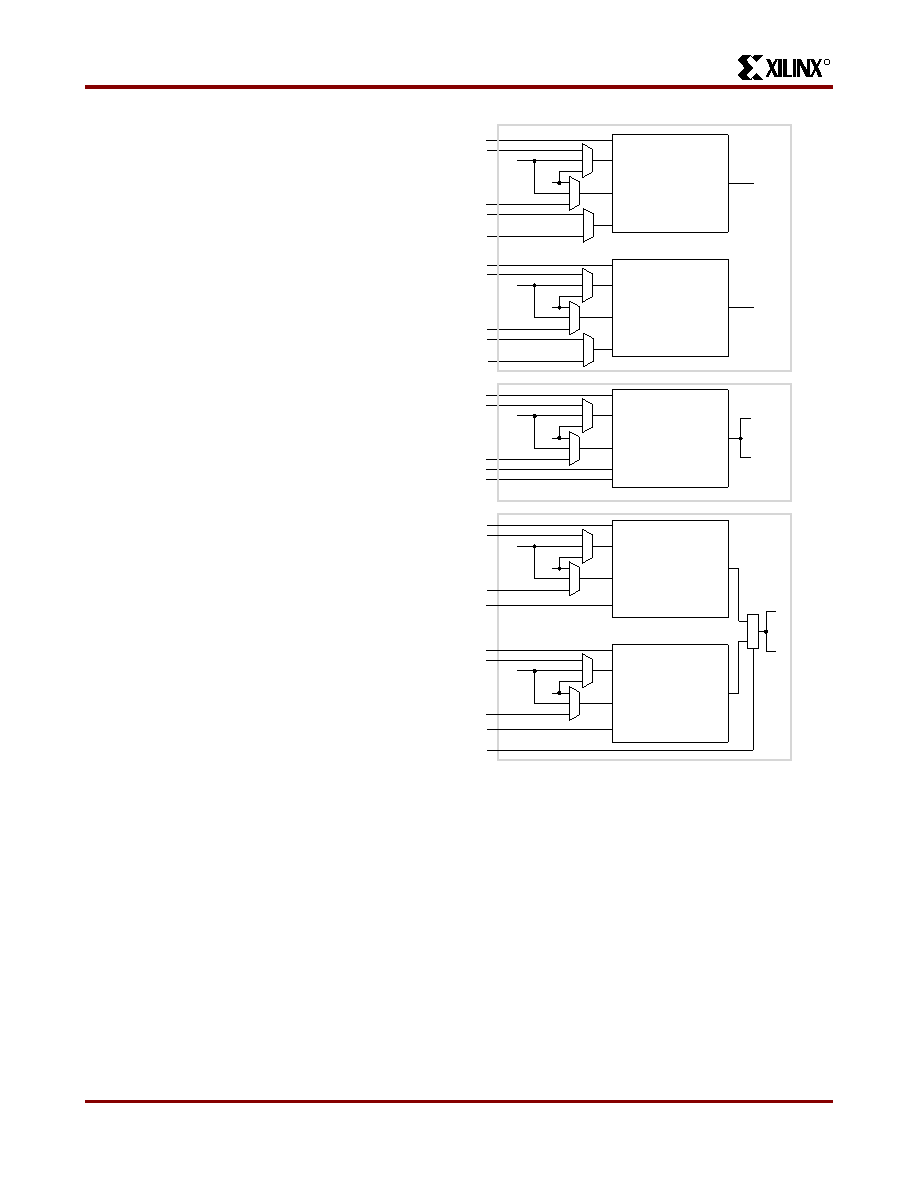- 您現(xiàn)在的位置:買賣IC網(wǎng) > PDF目錄4176 > XC3120A-3PC68C (Xilinx Inc)IC LOGIC CL ARRAY 2000GAT 68PLCC PDF資料下載
參數(shù)資料
| 型號: | XC3120A-3PC68C |
| 廠商: | Xilinx Inc |
| 文件頁數(shù): | 75/76頁 |
| 文件大小: | 0K |
| 描述: | IC LOGIC CL ARRAY 2000GAT 68PLCC |
| 產(chǎn)品變化通告: | XC4000XL/E, XC9500XV, XC3100A Discontinuance 12/Apr/2010 |
| 標準包裝: | 18 |
| 系列: | XC3000A/L |
| LAB/CLB數(shù): | 64 |
| RAM 位總計: | 14779 |
| 輸入/輸出數(shù): | 58 |
| 門數(shù): | 1500 |
| 電源電壓: | 4.25 V ~ 5.25 V |
| 安裝類型: | 表面貼裝 |
| 工作溫度: | 0°C ~ 85°C |
| 封裝/外殼: | 68-LCC(J 形引線) |
| 供應(yīng)商設(shè)備封裝: | 68-PLCC |
| 其它名稱: | 122-1037 |
第1頁第2頁第3頁第4頁第5頁第6頁第7頁第8頁第9頁第10頁第11頁第12頁第13頁第14頁第15頁第16頁第17頁第18頁第19頁第20頁第21頁第22頁第23頁第24頁第25頁第26頁第27頁第28頁第29頁第30頁第31頁第32頁第33頁第34頁第35頁第36頁第37頁第38頁第39頁第40頁第41頁第42頁第43頁第44頁第45頁第46頁第47頁第48頁第49頁第50頁第51頁第52頁第53頁第54頁第55頁第56頁第57頁第58頁第59頁第60頁第61頁第62頁第63頁第64頁第65頁第66頁第67頁第68頁第69頁第70頁第71頁第72頁第73頁第74頁當前第75頁第76頁

R
XC3000 Series Field Programmable Gate Arrays
7-10
November 9, 1998 (Version 3.1)
Flexible routing allows use of common or individual CLB
clocking.
The combinatorial-logic portion of the CLB uses a 32 by 1
look-up table to implement Boolean functions. Variables
selected from the five logic inputs and two internal block
flip-flops are used as table address inputs. The combinato-
rial propagation delay through the network is independent
of the logic function generated and is spike free for single
input variable changes. This technique can generate two
independent logic functions of up to four variables each as
shown in Figure 6a, or a single function of five variables as
shown in Figure 6b, or some functions of seven variables
as shown in Figure 6c. Figure 7 shows a modulo-8 binary
counter with parallel enable. It uses one CLB of each type.
The partial functions of six or seven variables are imple-
mented using the input variable (E) to dynamically select
between two functions of four different variables. For the
two functions of four variables each, the independent
results (F and G) may be used as data inputs to either
flip-flop or either logic block output. For the single function
of five variables and merged functions of six or seven vari-
ables, the F and G outputs are identical. Symmetry of the F
and G functions and the flip-flops allows the interchange of
CLB outputs to optimize routing efficiencies of the networks
interconnecting the CLBs and IOBs.
Programmable Interconnect
Programmable-interconnection resources in the Field Pro-
grammable Gate Array provide routing paths to connect
inputs and outputs of the IOBs and CLBs into logic net-
works. Interconnections between blocks are composed of a
two-layer grid of metal segments. Specially designed pass
transistors, each controlled by a configuration bit, form pro-
grammable interconnect points (PIPs) and switching matri-
ces used to implement the necessary connections between
selected metal segments and block pins. Figure 8 is an
example of a routed net. The development system provides
automatic routing of these interconnections. Interactive
routing is also available for design optimization. The inputs
of the CLBs or IOBs are multiplexers which can be pro-
grammed to select an input network from the adjacent
interconnect segments.
Since the switch connections to
block inputs are unidirectional, as are block outputs,
they are usable only for block input connection and not
for routing. Figure 9 illustrates routing access to logic
block input variables, control inputs and block outputs.
Three types of metal resources are provided to accommo-
date various network interconnect requirements.
General Purpose Interconnect
Direct Connection
Longlines (multiplexed busses and wide AND gates)
QY
Any Function
of Up to 4
Variables
QY
Any Function
of Up to 4
Variables
QY
Any Function
of 5 Variables
QY
Any Function
of Up to 4
Variables
QY
Any Function
of Up to 4
Variables
5c
5b
5a
QX
A
B
C
D
A
B
C
D
E
A
B
C
D
E
D
A
B
C
D
C
A
B
M
U
X
F
G
F
G
F
G
E
X5442
FGM
Mode
Figure 6: Combinational Logic Options
6a. Combinatorial Logic Option FG generates two func-
tions of four variables each. One variable, A, must be
common to both functions. The second and third variable
can be any choice of B, C, QX and QY. The fourth vari-
able can be any choice of D or E.
6b. Combinatorial Logic Option F generates any function
of five variables: A, D, E and two choices out of B, C, QX,
QY.
6c. Combinatorial Logic Option FGM allows variable E to
select between two functions of four variables: Both have
common inputs A and D and any choice out of B, C, QX
and QY for the remaining two variables. Option 3 can
then implement some functions of six or seven variables.
Product Obsolete or Under Obsolescence
相關(guān)PDF資料 |
PDF描述 |
|---|---|
| ASC49DRYN-S93 | CONN EDGECARD 98POS DIP .100 SLD |
| XC3090A-7PC84C | IC LOGIC CL ARRAY 9000GAT 84PLCC |
| XC3064A-7PC84C | IC LOGIC CL ARRAY 6400GAT 84PLCC |
| XC3064A-7PQ160C | IC LOGIC CL ARRAY 6400GAT 160PQF |
| ASC49DRYH-S93 | CONN EDGECARD 98POS DIP .100 SLD |
相關(guān)代理商/技術(shù)參數(shù) |
參數(shù)描述 |
|---|---|
| XC3120A-3PC68I | 制造商:XILINX 制造商全稱:XILINX 功能描述:Field Programmable Gate Arrays (XC3000A/L, XC3100A/L) |
| XC3120A-3PC84C | 制造商:XILINX 制造商全稱:XILINX 功能描述:Field Programmable Gate Arrays (XC3000A/L, XC3100A/L) |
| XC3120A-3PC84I | 制造商:XILINX 制造商全稱:XILINX 功能描述:Field Programmable Gate Arrays (XC3000A/L, XC3100A/L) |
| XC3120A-3PQ100C | 制造商:XILINX 制造商全稱:XILINX 功能描述:Field Programmable Gate Arrays (XC3000A/L, XC3100A/L) |
| XC3120A-3PQ100I | 制造商:XILINX 制造商全稱:XILINX 功能描述:Field Programmable Gate Arrays (XC3000A/L, XC3100A/L) |
發(fā)布緊急采購,3分鐘左右您將得到回復(fù)。